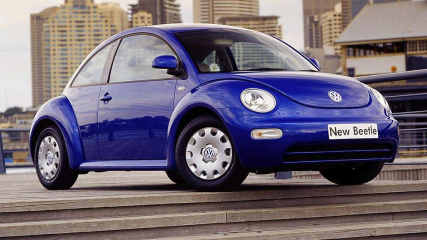Used Volkswagen Beetle review: 2000-2010
By Graham Smith · 26 Nov 2012
The new Beetle might look like the original 'People's Car' but in reality there's very little about the new car that can be traced back to the old model.NEW The engine is in the front of the new car, it is in the rear of the old one, the car's engine is water-cooled, the old one uses air for cooling, the new one is front-wheel drive, the old one is rear wheel drive. It goes on.The point is that you shouldn't be swayed by the spin that suggested the new Beetle is the old one reborn. It isn't.By all means buy it if you like the new car's cute looks, but be aware that what you are buying is a rather impractical Golf. When you boil it down the new Beetle is more a cute Golf than a new version of the old classic.It was launched here in 2000 initially as a single model with a 2.0-litre 85 kW engine with a heap of standard features that moved it up the model chain.Since then there has been a lower-spec 1.6-litre model, a turbo model, a diesel and a cabriolet. The 2.0-litre has decent torque giving it good response and driveability, the 1.6-litre is similar, the turbo offers the zing, while the diesel is the mileage buster.With its Golf underpinnings the Beetle is sure-footed and responsive, its ride is firm but comfortable, while it steers nicely and brakes with assurance.It is a thoroughly modern car with a retro look. Two doors necessarily limits a car's practicality when it comes to family use, getting in and out of the rear seats isn't something you want to do every day.And the rear seats are a little cramped. The boot isn't very big either, which just adds to its day-to-day limitations. Buying a 'Bug' of the new sort really comes down to image. If you want to feel funky, buy it, if you have to drive the kids to school go for something more practical.NOWBeing based on the Golf the Beetle suffers similar issues as its corporate cousin. The engines it used are sound and give little trouble, but take a look for oil leaks that might need addressing in the near term. Plastic engine fittings tend to get brittle and crumble over time.When it comes to transmissions, the Beetle didn't use the troublesome DSG gearbox, which means there aren't the same concerns as with other models in the VW range. Nevertheless thoroughly test-drive the automatic transmission and ensure it shifts smoothly and without hesitation. Early Beetles are now up around the 150,000 km mark on average and that's getting into auto trouble territory. Like all European cars the brakes tend to wear quite quickly, so be prepared to replace pads and discs regularly. Faulty electronics are a regular complaint on all cars today, which makes it worth checking every system in the car to ensure they're operating as they should.SMITHY SAYS Oldtime looks make it stand out from the crowd, but under the skin it's all modern, if a little impractical for some.VW Beetle - 2000-2010Price new: $36,790 to $39,990Engines: 1.6-litre 4-cylinder, 75 kW/148 Nm; 2.0-litre 4-cylinder, 85kW/172Nm; 1.8-litre turbocharged 4-cylinder, 110kW/210Nm; 1.9-litre 4-cylinder turbo-diesel, 77kW/250NmTransmissions: 5-speed manual, 4-speed auto, 6-speed auto, FWDThirst: 8.2 L/100 km (1.6); 8.8 L/100 km (2.0), 8.2 L/100 km (1.8T); 5.5 L/100 km (TD)Body: 2-door hatch, 2-door cabrioletVariants: Base, Ikon, Miami, TDi, TurboSafety: 4-star ANCAPCOMING UPDo you own a VW Golf GTi? If so tell us what you think of it by sending your comments to Graham Smith at grah.smith@bigpond.com or Carsguide, PO Box 4245, Sydney, NSW, 2010.

